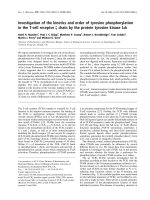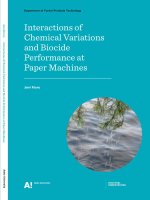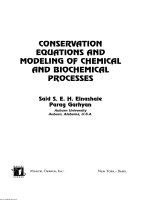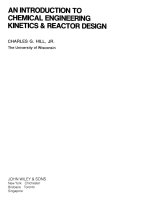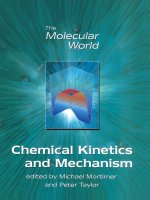modeling of chemical kinetics and reactor design by a. kayode coker
Bạn đang xem bản rút gọn của tài liệu. Xem và tải ngay bản đầy đủ của tài liệu tại đây (15.32 MB, 1,126 trang )
Modeling of
Chemical Kinetics
and
Reactor Design
Modeling of
Chemical Kinetics
and
Reactor Design
A. Kayode Coker, Ph.D.
Lecturerer and Consultant, AKC Technology
Boston Oxford Johannesburg Melbourne New Delhi Singapore
iv
Modeling of
CHEMICAL KINETICS AND
REACTOR DESIGN
Copyright © 2001 by Gulf Publishing Company, Houston, Texas. All rights
reserved. Printed in the United States of America. This book, or parts thereof,
may not be reproduced in any form without permission of the publisher.
Gulf Publishing Company
Book Division
P.O. Box 2608, Houston, Texas 77252-2608
Library of Congress Cataloging-in-Publication Data
(To come)
ISBN 0-88415-481-5
Printed in the United States of America.
Printed on acid-free paper (∞).
Dedication
To my wife Victoria and the boys Akin and Ebun,
love and thanks.
v
Acknowledgments
I wish to express my gratitude to the following for giving their time
in proofreading various sections of the text: Drs. A. A. Adesina,
L. M. Rose, C. J. Mumford, and J. D. Jenkins. I am indebted to
Emeritus Professor Octave Levenspiel for his encouragement and
advice in some chapters of the text, and to Drs. Waldram and Singh
for their comments, suggestions on safety in reaction engineering, and
the inclusion of HEL safety photographs in the text. I would also like
to thank Mr. Ed Steve for his comments and suggestions on scale-up
of reactors, and Mr. Joseph Rivera for some of the figures in the text. I
wish to express my gratitude to Drs. A. Bakker, J. B. Fasano, and V. V.
Ranade for contributing to Chapter 10 (Computational Fluid Dynamics
and Computational Fluid Mixing). I would like to acknowl-edge the
following companies for the use of their materials: Arthur D. Little,
HEL, M. W. Kellogg Ltd., Stone & Webster, Fauske & Associates, Inc.,
Simulation Sciences Inc., Chemineer, PROCEDE, and Absoft Corporation.
I would like to express my gratitude to the following institutions
for permission to reproduce their materials: Institution of Chemical
Engineers (U.K.), the American Institute of Chemical Engineers and
Chemical Engineering—a publication of Chemical Week Associates.
I am also indebted to those whose work was drawn.
I thank Dr. E. L. Smith for his comments and suggestions during
the preparation of some of the chapters in the text and wish him a
happy retirement. It has been a pleasure to have learned so much from
him during his tenure at Aston University.
Sincere gratitude to Tim Calk of Gulf Publishing Company for his
direction and editing of the book, to Danette DeCristofaro and Jerry
Hayes of ExecuStaff for their excellent production of the book, to Mr.
Phil Carmical and Ms. Jennifer Plumley of Butterworth-Heinemann for
the production of the CD-ROM.
vi
My thanks to Ahmed Mutawa of Saudi Aramco Shell Refinery
(SASREF), an excellent student in the short course program for
developing conversion table software for the book.
In gratitude to the Almighty father, the Omnipotence, Omniscience,
and Omnipresence.
A. Kayode Coker, Ph.D.
Nippon Petroleum FCC Unit—Japan.
(Courtesy M. W. Kellogg Ltd.)
vii
Contents
Preface xiii
Introduction xvii
CHAPTER ONE
Reaction Mechanisms and Rate Expressions 11
Introduction 1
Typical Reaction Mechanisms 5
Reaction Mechanisms 8
Elementary and Non-Elementary Reactions 9
Types of Intermediate 10
The Arrhenius Equation and the Collision Theory 12
Transition State Theory 15
Chain Reactions 16
Catalytic Reactions 21
Guidelines to Formulating Reaction Mechanism 32
Testing Kinetic Models 34
Chain Length 37
References 58
CHAPTER TWO
Thermodynamics of Chemical Reactions 59
Introduction 59
Chemical Equilibrium 60
Criteria for Equilibrium 63
Reaction Equilibrium 64
Ideal Gas Mixtures 65
Real Gases—Ideal Gaseous Solutions 65
Real Gases 67
Liquid State 69
Determining the Fugacity and the Fugacity Coefficient 70
Partial Molar Quantities 72
Effect of Temperature on the Equilibrium Constant 74
viii
Heats of Reaction 75
Heat Capacities of Gases 80
Heats of Formation 80
References 93
Appendix 94
CHAPTER THREE
Reaction Rate Expression 109
Introduction 109
Reaction Rate Equation 110
Reaction Orders 114
Determining the Order of Reactions 116
Empirical Rate Equations of the nth Order 129
Method of Half-Life t
1/2
130
Parallel Reactions 134
Homogeneous Catalyzed Reactions 137
Autocatalytic Reactions 138
Irreversible Reactions in Series 140
First Order Reversible Reactions 146
Second Order Reversible Reactions 150
General Reversible Reactions 151
Simultaneous Irreversible Side Reaction 152
Pseudo-Order Reaction 154
Practical Measurements of Reaction Rates 155
Regression Analysis 171
Weighted Least Squares Analysis 173
Problems and Errors in Fitting Rate Models 175
References 216
CHAPTER FOUR
Industrial and Laboratory Reactors 218
Introduction 218
Batch Isothermal Perfectly Stirred Reactor 220
Semi-Batch Reactors 222
Continuous Flow Isothermal Perfectly Stirred Tank Reactor 226
Continuous Isothermal Plug Flow Tubular Reactor 227
Continuous Multiphase Reactors 230
Fluidized Bed System 232
Fluid Catalytic Cracking (FCC) Unit 234
Deep Catalytic Cracking Unit 235
Determining Laboratory Reactors 243
Guidelines for Selecting Batch Processes 254
ix
Guidelines for Selecting Batch Processes 254
References 259
CHAPTER FIVE
Introduction to Reactor Design Fundamentals
for Ideal Systems 260
Introduction 260
A General Approach 262
Ideal Isothermal Reactors 264
Numerical Methods for Reactor Systems Design 279
Reversible Series Reactions 287
The Semibatch Reactor 306
Continuous Flow Stirred Tank Reactor (CFSTR) 312
Multi-Stage Continuous Flow Stirred Tank Reactor 327
Equal Size CFSTR In Series 334
Space Time (ST) and Space Velocity (SV) 349
Fractional Conversion, Yield, and Selectivity in Reactors 351
Relationship Between Conversion, Selectivity, and Yield 353
Plug Flow Reactor 362
Heterogeneous Tubular Reactor 371
Design Equation for Systems of Variable Density 372
Design Equations for Heterogeneous Reactions 375
Comparison of Ideal Reactors 387
CFSTR and Plug Flow Systems 396
Dynamic Behavior of Ideal Systems 400
Flow Recycle Reactor 410
References 423
CHAPTER SIX
Non-Isothermal Reactors 424
Introduction 424
Operating Temperature, Reaction Types, and Temperature 425
Effect of Operating Parameters on Equilibrium Conversion 429
Energy Balance and Heat of Reaction 429
Energy Transferred between the System and Surroundings 434
Batch Reactor 457
Plug Flow Reactor 472
Autothermal Reactors 477
Conversion in Ammonia Synthesis 478
Two-Dimensional Tubular (Plug Flow) Reactor 492
Pressure Drop (∆P) in Tubular (Plug Flow) Reactors 494
Thermal Behaviors in Flow Systems 500
x
Exothermic Reactions in CFSTRs 504
Thermal Behavior of a Tubular Flow Reactor 507
Variable Coolant Temperature in a CFSTR 515
Optimal Design of Non-Isothermal Reactors 518
Mimimum Reactor Volume at the Optimum Temperature
Progression (OTP) of a Single CFSTR with a Reversible
Exothermic Reaction 543
Optimum Reactor Size 546
References 551
CHAPTER SEVEN
Fluid Mixing in Reactors 552
Introduction 552
Mixing and Agitation of Fluids 553
Similarity 570
Mixing Time Correlation 578
Scale-up of Mixing Systems 584
Static Mixers 597
Heat Transfer in Agitated Vessels 615
Liquid-Solid Agitation 634
Batch Heating and Cooling of Fluids 636
Design of Mixing Systems 656
References 659
CHAPTER EIGHT
Residence Time Distributions in Flow Reactors 663
Introduction 663
The Residence Time Distribution Functions and
their Relationships 664
Determining RTD from Experimental Tracer Curves 680
Analysis of RTD from Pulse Input 688
Residence Time Distribution for a Laminar
Flow Tubular Reactor 708
E- and F-Curves for a Series of Stirred Tank Reactors 713
RTD Functions for CSTRs Where N Is Not an Integer 721
The Dispersion Model 723
Comparison of Tank In Series (TIS) and Dispersion
Plug Flow (DPF) Models 746
Residence Time Distribution in a Static Mixer 747
Glossary 756
References 760
xi
CHAPTER NINE
Models for Non-Ideal Systems 762
Introduction 762
Basics of Non-Ideal Flow 762
Segregated Flow Model 764
Complete Segregation Model with Side Exits 770
Maximum Mixedness Model (MMM) 772
Effect of Micromixing on Conversion 774
References 782
CHAPTER TEN
Application of Computational Fluid Dynamics
and Computational Fluid Mixing in Reactors 783
Introduction 783
Theory and Fluid Flow Equations 786
Turbulence on Time-Averaged Navier-Stokes Equations 792
Time-Dependent Turbulent Mixing and Chemical Reaction
in Stirred Tanks 794
References and Recommended Reading 810
Nomenclature 810
Improve Reactors Via Computational Fluid Dynamics 811
References 828
CHAPTER ELEVEN
Biochemical Reaction 830
Introduction 830
Kinetics of Enzyme-Catalyzed Reactions 831
Models of Enzyme Kinetics 834
Enzyme Kinetics in the Presence of an Inhibitor 851
Fermentation 853
Design of Biological Reactors 855
Vessel Design and Aspect Ratio 857
Types of Operation 863
Cell Growth 863
Modeling Biological Reactors 868
General Model for a Single Vessel 872
The Chemostat 876
Batch Fermenter 884
Fed-Batch Reactor 887
Scale-up of Bioreactors 889
Nomenclature 898
xii
Glossary 899
References 908
CHAPTER TWELVE
Safety in Chemical Reaction Engineering 910
Introduction 910
Hazard Evaluation in the Chemical Process Industries 911
Hazard Assessment Procedures 916
Thermal Runaway Chemical Reaction Hazards 919
The φ-Factor 920
Onset Temperature 923
Test Instruments 926
Two-Phase Flow Relief Sizing for Runaway Reaction 950
Vent Sizing Methods 963
Discharge System 973
Inherently Safe Plants in Reactor Systems 984
Hazard and Operability Studies (HAZOP) 991
Glossary 1010
References 1018
Appendix 1022
CHAPTER THIRTEEN
Scale-Up in Reactor Design 1034
Introduction 1034
Development and Scale-Up of Reactors 1036
Similarity Criteria 1037
Scale-Up in Relation to Various Factors 1037
Heat Effect 1038
Coefficients of Process Stability 1039
Dimensional Analysis and Scale-Up Equations 1040
Mathematical Modeling 1044
Scale-Up of a Batch Reactor 1047
Heat Transfer Model 1057
Jacket Zoning of a Batch Reactor 1065
The Outlet Temperature of a Scaled-Up Batch System 1070
Aspect Ratio (R) in Jacket Zoning and Scale-Up of a
Batch Reactor 1074
Nomenclature 1079
References 1080
Nomenclature 1082
Index 1089
About the Author 1096
xiii
Preface
SCOPE
This valuable reference volume conveys a basic understanding of
chemical reactor design methodologies that incorporate both scale-up
and hazard analysis. It shows readers how to select the best reactor
for any particular chemical reaction, how to estimate its size, and how
to obtain the best operating conditions.
An understanding of chemical reaction kinetics and the design of
chemical reactors is very important to the chemist and the chemical
engineer. Engineers share interests in fluid mechanics and transport
phenomena, while the chemist deals with the kinetics and mechanisms
of reactions. The chemical engineer combines the knowledge of these
subjects for the better understanding, design, and control of the reactor.
The recent accidents that have occurred in the chemical process
industries with inherent fatalities and environmental pollution have
imposed greater demands on chemical engineers. Consequently, chemical
reactor design methodologies must incorporate both control and hazard
analysis. However, the design of chemical reactors is still essential for
its proper sizing, and is included in various types of process simulators.
In an industrial problem, it is essential to select the best type of reactor
for any particular chemical reaction. Additionally, it is necessary to
estimate its size and determine the best operating conditions. The
chemical engineer confronted with the design of various reactor types
often depends on the scale of operation and the kinetics.
Many excellent texts have appeared over the years on chemical
reactor design. However, these texts often lack sections on scale-up,
biochemical reactor design, hazard analysis, and safety in reactor
design methodology. The purpose of this book is to provide the basic
theory and design and, sometimes, computer programs (Microsoft Excel
spreadsheet and software) for solving tedious problems. This speeds up
the work of both chemists and engineers in readily arriving at a solution.
The following highlights some of the subjects that are covered in this text.
xiv
MIXING
An important unit operation in chemical reaction engineering,
mixing, finds application in petrochemicals, food processing, and
biotechnology. There are various types of fluid mixing such as liquid
with liquid, gas with liquid, or solids with liquid. The text covers
micromixing and macromixing, tracer response and residence time
distribution (RTD), heat transfer, mixing fundamentals, criteria for
mixing, scale of segregation, intensity of segregation, types of impellers,
dimensional analysis for liquid agitation systems, design and scale-up
of mixing pilot plants, the use of computational fluid dynamics (CFD)
in mixing, and heat transfer in agitated vessels.
BIOCHEMICAL REACTION
This is an essential topic for biochemists and biochemical engineers.
Biochemical reactions involve both cellular and enzymatic processes,
and the principal differences between biochemical and chemical
reactions lie in the nature of the living systems. Biochemists and
biochemical engineers can stabilize most organic substances in processes
involving microorganisms.
This chapter discusses the kinetics, modeling and simulation of
biochemical reactions, types and scale-up of bioreactors. The chapter
provides definitions and summary of biological characteristics.
CHEMICAL REACTOR MODELING
This involves knowledge of chemistry, by the factors distinguishing
the micro-kinetics of chemical reactions and macro-kinetics used to
describe the physical transport phenomena. The complexity of the
chemical system and insufficient knowledge of the details requires that
reactions are lumped, and kinetics expressed with the aid of empirical
rate constants. Physical effects in chemical reactors are difficult to
eliminate from the chemical rate processes. Non-uniformities in the
velocity, and temperature profiles, with interphase, intraparticle heat,
and mass transfer tend to distort the kinetic data. These make the
analyses and scale-up of a reactor more difficult. Reaction rate data
obtained from laboratory studies without a proper account of the
physical effects can produce erroneous rate expressions. Here, chemical
reactor flow models using mathematical expressions show how physical
xv
processes interact with chemical processes. The proposed model must
represent the flow behavior of an actual reactor, which is realistic
enough to give useful information for its design and analysis. The text
reviews different reactor flow models.
SAFETY IN CHEMICAL REACTION
Equipment failures or operator errors often cause increases in
process pressures beyond safe levels. A high increase in pressure may
exceed the set pressure in pipelines and process vessels, resulting in
equipment rupture and causing major releases of toxic or flammable
chemicals. A proper control system or installation of relief systems can
prevent excessive pressures from developing. The relief system con-
sists of the relief device and the associated downstream process
equipment (e.g., knock-out drum, scrubber, absorbers, and flares) that
handles the discharged fluids. Many chemical reactions (e.g., poly-
merization, sulphonation, nitration) in the chemical process industry
result in runaway reactions or two-phase flow. This occurs when an
exothermic reaction occurs within a reactor. If cooling no longer exists
due to a loss of cooling water supply or failure of a control system
(e.g., a valve), then the reactor temperature will rise. As the temperature
rises, the reaction rate increases, leading to an increase in heat genera-
tion. This mechanism results in a runaway reaction. The pressure
within the reactor increases due to increased vapor pressure of the
liquid components and gaseous decomposition products as a result of
the high temperature. Runaway reactions can occur within minutes for
large commercial reactors and have resulted in severe damage to a
complete plant and loss of lives. This text examines runaway reactions
and two-phase flow relief.
SCALE-UP
The chemical engineer is concerned with the industrial application
of processes. This involves the chemical and microbiological con-
version of material with the transport of mass, heat and momentum.
These processes are scale-dependent (i.e., they may behave differently
in small and large-scale systems) and include heterogeneous chemical
reactions and most unit operations. The heterogeneous chemical reactions
(liquid-liquid, liquid-gas, liquid-solid, gas-solid, solid-solid) generate
or consume a considerable amount of heat. However, the course of
xvi
such chemical reactions can be similar on both small and large scales.
This happens if the mass and heat transfer processes are identical and
the chemistry is the same. Emphasis in this text is on dimensional
analysis with respect to the following:
• Continuous chemical reaction processes in a tubular reactor.
• Influence of back mixing (macromixing) on the degree of con-
version and in continuous chemical reaction operation.
• Influence of micro mixing on selectivity in a continuous chemical
reaction process.
• Scale-up of a batch reactor
AN INTEGRATING CASE STUDY—AMMONIA SYNTHESIS
This book briefly reviews ammonia synthesis, its importance in the
chemical process industry, and safety precautions. This case study is
integrated into several chapters in the text. See the Introduction for
further details.
Additionally, solutions to problems are presented in the text and the
accompanying CD contains computer programs (Microsoft Excel
spreadsheet and software) for solving modeling problems using numerical
methods. The CD also contains colored snapshots on computational
fluid mixing in a reactor. Additionally, the CD contains the appendices
and conversion table software.
A. Kayode Coker, Ph.D.
xvii
Introduction
Increased collaboration between chemical reaction engineering and
chemistry disciplines in recent years has produced significant advances
in kinetic and thermodynamic modeling of processes. Additionally,
improvement in analytical chemistry techniques, the formulation of
mathematical models, and the development of computational tools have
led to a deeper understanding of complex chemical reaction kinetics,
particularly in mixtures with large numbers of compounds. Activities
in both academic and industrial research organizations have enabled
these groups to review the state of the art and cooperate with the
overall objectives of improving the safety, yields, and quality of the
products. Also, the final commitment to the production of any chemical
product often depends on its profitability and other economic factors.
Chemical kinetics mainly relies on the rates of chemical reactions
and how these depend on factors such as concentration and temperature.
An understanding of chemical kinetics is important in providing
essential evidence as to the mechanisms of chemical processes. Although
important evidence about mechanisms can be obtained by non-kinetic
investigations, such as the detection of reaction intermediates, knowledge
of a mechanism can be confirmed only after a detailed kinetic investi-
gation has been performed. A kinetic investigation can also disprove
a mechanism, but cannot ascertain a mechanism.
Kinetic investigations cover a wide range from various viewpoints.
Chemical reactions occur in various phases such as the gas phase, in
solution using various solvents, at gas-solid, and other interfaces in
the liquid and solid states. Many techniques have been employed for
studying the rates of these reaction types, and even for following fast
reactions. Generally, chemical kinetics relates to the studies of the rates
at which chemical processes occur, the factors on which these rates
depend, and the molecular acts involved in reaction mechanisms.
Table 1 shows the wide scope of chemical kinetics, and its relevance
to many branches of sciences.
xviii
CASE STUDY
As an introduction to the modeling of chemical kinetics and reactor
design, consider the manufacture of ammonia. The synthesis of ammonia
is performed on a large scale with over 100 million tons produced each
year. Computer simulation of the plant is increasingly employed as
the first stage in identifying which parameters control the conversion
rate, the product purity, the energy expended, and the production rate.
The economic considerations that affect the reduction of costs with
increased efficiency and profitability are high. The principal licensors
of ammonia synthesis are ICI, Braun, and M.W. Kellogg. Figure 1
shows a typical ammonia plant.
Ammonia is one of the largest volume inorganic chemicals in the
chemical process industries. Its major applications are in the pro-
duction of fertilizers, nitrates, sulfates, phosphates, explosives, plastics,
resins, amines, amides, and textiles. The fertilizer industry is the
largest user of ammonia, and large quantities must be stored to meet
the demand and maintain constant production levels. Ammonia may
be stored in very large insulated tanks at pressure near ambient; in
large spheres at a moderate pressure, refrigerated to reduce the
pressure; and at ambient temperature but higher pressure, corresponding
Table 1
Some branches of science to which kinetics is relevant [1]
Branch Applications of kinetics
Biology Physiological processes (e.g., digestion and metabolism),
bacterial growth
Chemical engineering Reactor design
Electrochemistry Electrode processes
Geology Flow processes
Inorganic chemistry Reaction mechanisms
Mechanical engineering Physical metallurgy, crystal dislocation mobility
Organic chemistry Reaction mechanisms
Pharmacology Drug action
Physics Viscosity, diffusion, nuclear processes
Psychology Subjective time, memory
xix
Figure 1. Tugas ammonia plant
—Gemlik,
Turkey.
(Courtesy M. W. Kellogg Ltd.)
xx
to the vapor pressure at ambient temperature. Table 2 shows the raw
materials requirements, yield, and properties of ammonia.
Transportation is by railroad tank vehicle, by tank truck, or by
pipeline. In this case, transportation at ambient temperature is the best
choice. The choice of storing ammonia at an ambient temperature
liquid or partially refrigerated liquid or an ambient pressure liquid
depends mostly on economic factors. One of the factors that deter-
mines the storage method is the quantity of ammonia to be stored.
Ammonia is toxic and flammable, although the lower flammable
limit is quite high and fires in ammonia facilities are rare. However,
spillage from storage vessel or transfer piping must be considered and
adequate precautions taken to minimize its effect. Storage tanks must
have adequate vents so the pressure cannot rise above safe levels, and
are diked to prevent the spread of liquid in case of a spill. For ambient
pressure storage, the vents must be large in area and operate at
pressures only slightly above ambient pressure. Alternatively, for
ambient temperature, the vents are smaller, but operate at much higher
pressure. At ambient temperature, ammonia in common with other
liquified gases must have sufficient ullage space in the tank to allow
for expansion when the temperature rises. Otherwise, liquid loaded into
Table 2
Raw materials requirements and yield
Raw materials required per ton of ammonia:
Natural gas: 810 m
3
Yield: 85%
Properties: Colorless liquid or gas with a very pungent odor. Soluble in water,
ethyl alcohol, and ether.
Molecular weight: 17.03 Vapor density (air = 1): 0.597
Density at 20°C (gas): 0.771
Melting point: –77.7°C Boiling point: –33.4°C
Autoignition temperature: 651°C
Critical temperature, T
C
: 132.4°C
Critical pressure, P
C
: 111.3°C
Critical volume, V
C
: 72.4 cm
3
/gmol
Critical compressibility factor Z: 0.243
xxi
the tank from refrigerated storage will expand to cause the tank to be
full of liquid as it heats. The tank vent would then open and subsequently
leak liquid ammonia to the atmosphere. Training personnel for the
hazardous nature of anhydrous ammonia and how to handle emergency
conditions in the plant is essential.
The American Conference of Government Industrial Hygienists
(ACGIH) has established threshold doses called the threshold limit
values (TLVs) for many chemical agents. The TLV is the airborne
concentration that corresponds to conditions where no adverse effects
are normally expected during a worker’s lifetime. The exposure is
assumed to occur only during normal working hours, eight hours per
day and five days per week.
TLVs are calculated using ppm (parts per million by volume), mg/
m
3
(mg of vapor per cubic meter of air). For vapor, mg/m
3
is con-
verted to ppm by the equation:
C Conc
T
P
mg
m
T
PM
mg
m
ppm
W
=
=
.,
.
•
,
in ppm =
22.4
M
W
273
1
0 08205
3
3
where T = temperature in K
P = absolute pressure in atm
M
W
= molecular weight in gm/gm – mole
Table 3 gives the threshold limit value (TLV) and permissible
exposure level (PEL) of ammonia.
Table 3
U.S.
Threshold Safety and
Limit Administration
Value (TLV), Value Permissible OSHA
time average, Exposure Exposure,
weighted mg/m
3
Level (PEL), mg/m
3
Substance ppm at 25° C ppm at 25° C
Ammonia 25 18 25 18
xxii
The raw material source for ammonia plants is natural gas for
producing hydrogen by steam reforming. An alternative raw material
is naphtha, which also requires partial oxidation. Hydrogen streams
from catalytic reformers are another source of hydrogen. However, the
volumes available are negligible to meet the requirements of an
average size ammonia plant. Nitrogen is obtained by the liquefaction
of air or from producer gas mixed with hydrogen in the mole ratio
of 3:1.
The synthesis of ammonia is divided into four stages. In stage 1,
the natural gas undergoes catalytic reforming to produce hydrogen
from methane and steam. The nitrogen required for ammonia pro-
duction is introduced at this stage. Stage 2 involves the "synthesis gas"
(syngas) that is purified by removing both carbon monoxide and
carbon dioxide. Stage 3 is the compression of the syngas to the
required pressure. Stage 4 is the ammonia loop. A typical feed stock
for ammonia synthesis is 0.17 million standard cubic meter per day
(6 Mscfd) of natural gas at a temperature of 16°C and a pressure of
23.4 barg. Table 4 shows its composition.
Natural gas is desulfurized because sulfur has an adverse effect on
the catalysts used in the reforming and synthesis reactions. After
desulfurization and scrubbing, the natural gas is mixed with super-
heated steam at 23 barg and 510°C. Nitrogen is supplied from the air,
which is fed to the secondary reformer at 20 barg and 166°C. Table
5 shows the composition of air.
Table 4
Natural gas feed
Component Mole %
Carbon dioxide (CO
2
) 2.95
Nitrogen (N
2
) 3.05
Methane (CH
4
) 80.75
Ethane (C
2
H
6
) 7.45
Propane (C
3
H
8
) 3.25
Butane (C
4
H
10
) 2.31
Pentane (C
5
H
12
) 0.24
Used with permission from Simulation Sciences Inc.
xxiii
STAGE 1: CATALYTIC REFORMING
After the removal of sulfur, the primary steam reformer converts
about 70% of the hydrocarbon feed into synthesis gas. Methane is
mixed with steam and passed over a nickel catalyst. The main reform-
ing reactions are:
CH H O CO H
42 2
3++ [
CO H O CO H++
222
[
The catalytic steam hydrocarbon reforming process produces raw
synthesis gas by steam reforming under pressure. The reactions are
endothermic, thus the supply of heat to the reformer is required to
maintain the desired reaction temperature. The gases leaving the
reformer are CH
4
, 6 mol/%; CO, 8%; CO
2
, 6%; H
2
, 50%; and H
2
O,
30%. The operating pressure is between 20–35 bar, and the gases
leaving the reformer contain about 6% CH
4
. This represents approxi-
mately 30% of the original natural gas input. Figure 2 shows the
process flowsheet of catalytic reforming.
In the secondary reformer, air is introduced to supply the nitrogen
required for the 3:1 hydrogen H
2
and nitrogen N
2
synthesis gas. The
heat of combustion of the partially reformed gas supplies the energy
to reform the remaining hydrocarbon feed. The reformed product steam
is employed to generate steam and to preheat the natural gas feed.
STAGE 2: SHIFT AND METHANATION CONVERSION
The shift conversion involves two stages. The first stage employs
a high-temperature catalyst, and the second uses a low-temperature
catalyst. The shift converters remove the carbon monoxide produced
in the reforming stage by converting it to carbon dioxide by the reaction
Table 5
Air feed
Component Mole %
Oxygen (O
2
) 21.0
Nitrogen (N
2
) 78.05
Argon (Ar) 0.95
xxiv
Figure 2. Catalytic reforming flowsheet.
(Used with permission of Simulation
Sciences Inc.)
CO H O CO H++
222
[
The reaction produces additional hydrogen for ammonia synthesis.
The shift reactor effluent is cooled and the condensed water is separated.
The gas is purified by removing carbon dioxide from the synthesis
gas by absorption with hot carbonate, Selexol, or methyl ethyl amine
(MEA). After purification, the remaining traces of carbon monoxide
and carbon dioxide are removed in the methanation reactions.
CO H CH H O++3
242
[
CO H CH H O
22 42
42++
[
Figure 3 illustrates the shift and methanation conversion. The
resulting methane is inert and the water is condensed. Thus purified,
the hydrogen-nitrogen mixture with the ratio of 3H
2
: 1N
2
is com-
pressed to the pressure selected for ammonia synthesis.
STAGE 3: COMPRESSION PROCESS
The purified synthesis gas is cooled and the condensed water is
removed. The syngas is then compressed in a series of centrifugal
xxv
Figure 3. Shift and methanation process flow diagram.
(Used with permission
of Simulation Sciences Inc.)
compressors with interstage cooling to a pressure of 150 bar. The
centrifugal compressors are driven by steam turbines using steam
generated in the plant itself. This reduces the overall power consump-
tion. Coker [2] illustrates the design of a centrifugal compressor.
Figure 4 shows the compressor with interstage cooling.
STAGE 4: CONVERSION UNIT
The compressed synthesis gas is dried, mixed with a recycle stream,
and introduced into the synthesis reactor after the recycle compressor.
The gas mixture is chilled and liquid ammonia is removed from the
secondary separator. The vapor is heated and passed into the ammonia
converter. The feed is preheated inside the converter prior to entering
the catalyst bed. The reaction occurs at 450–600°C over an iron oxide
catalyst. The ammonia synthesis reaction between nitrogen, N
2
, and
hydrogen, H
2
, is
NH NH
22 3
32+ [
The reaction is an equilibrium reaction that is exothermic. Lower
temperatures favor the production of ammonia. High pressures in




